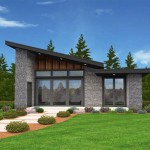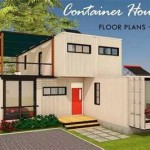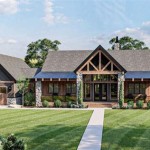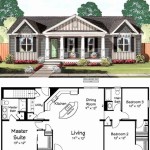Apartment house design plans are meticulous blueprints that outline the architectural layout, dimensions, and specifications for constructing an apartment building. These plans serve as a comprehensive guide for engineers, architects, and builders during the construction process, ensuring the project’s adherence to building codes and the desired aesthetic vision.
A well-designed apartment house plan balances functionality and aesthetics, prioritizing factors such as space optimization, natural light utilization, ventilation, and flow of movement within the building. For instance, a plan may incorporate open floor plans to enhance spaciousness, while strategically placed windows and balconies maximize natural light and provide panoramic views.
In the following sections of this article, we will delve into the key elements and considerations involved in apartment house design plans. We will explore aspects such as unit layouts, building materials, energy efficiency, and sustainable design strategies. Through real-world examples and expert insights, we will provide a comprehensive understanding of the planning and design process for apartment buildings.
Apartment house design plans should consider the following key points:
- Floor plan optimization
- Natural light utilization
- Ventilation and air flow
- Energy efficiency
- Sustainable design
- Building materials
- Safety and accessibility
- Parking and storage
- Outdoor amenities
- Cost-effectiveness
By addressing these elements, apartment house design plans can create functional, comfortable, and aesthetically pleasing living spaces that meet the needs of residents and promote a high quality of life.
Floor plan optimization
Floor plan optimization in apartment house design plans involves creating efficient and functional layouts that maximize space utilization and flow of movement within each unit. This is achieved by carefully considering the placement of rooms, hallways, windows, and doors, as well as the overall shape and dimensions of the apartment.
One key aspect of floor plan optimization is to minimize wasted space. This can be done by eliminating unnecessary hallways and corridors, and by designing rooms that are multi-functional and can serve multiple purposes. For example, a living room can be designed to incorporate a dining area or a home office space.
Another important consideration is natural light utilization. Well-placed windows and balconies can bring ample natural light into the apartment, creating a brighter and more inviting living space. This can also help reduce energy consumption by reducing the need for artificial lighting.
Finally, floor plan optimization should also take into account the flow of movement within the apartment. The layout should be designed to allow for easy and efficient movement between different rooms and areas, without creating any bottlenecks or obstacles.
By carefully considering all of these factors, architects can create apartment house design plans that maximize space utilization, natural light, and flow of movement, resulting in functional and comfortable living spaces for residents.
Natural light utilization
Natural light utilization is a key consideration in apartment house design plans, as it has a significant impact on the overall livability and well-being of residents. Well-placed windows and balconies can bring ample natural light into the apartment, creating a brighter and more inviting living space. This can also help reduce energy consumption by reducing the need for artificial lighting.
There are a number of factors to consider when designing for natural light utilization. One important factor is the orientation of the building. Buildings that are oriented to face south will receive the most sunlight throughout the day. Another factor to consider is the size and placement of windows. Larger windows will allow more light into the apartment, and windows that are placed high on the wall will allow light to penetrate deeper into the space.
In addition to windows, balconies and other outdoor spaces can also be used to bring natural light into the apartment. Balconies can be designed to be partially or fully enclosed, allowing residents to enjoy the outdoors while still being protected from the elements. Other outdoor spaces, such as courtyards and gardens, can also be used to provide natural light and ventilation to the building.
By carefully considering all of these factors, architects can create apartment house design plans that maximize natural light utilization, resulting in brighter, more comfortable, and more energy-efficient living spaces for residents.
Ventilation and air flow
Ventilation and air flow are essential considerations in apartment house design plans, as they impact the health, comfort, and well-being of residents. Proper ventilation helps to remove stale air, pollutants, and moisture from the apartment, while also providing fresh air from the outdoors. This is important for maintaining a healthy indoor environment and preventing the buildup of harmful substances.
There are a number of factors to consider when designing for ventilation and air flow. One important factor is the type of ventilation system used. There are two main types of ventilation systems: natural ventilation and mechanical ventilation. Natural ventilation relies on natural forces, such as wind and temperature differences, to move air through the building. Mechanical ventilation uses fans or other mechanical devices to move air through the building.
The choice of ventilation system will depend on a number of factors, including the size and layout of the building, the climate, and the budget. Natural ventilation is typically less expensive to install and operate than mechanical ventilation. However, mechanical ventilation can provide more consistent and controlled ventilation, which may be necessary in certain climates or for buildings with complex layouts.
In addition to the ventilation system, the design of the building itself can also impact ventilation and air flow. The placement of windows, doors, and other openings can be used to create cross-ventilation, which is the movement of air through a space from one side to the other. Cross-ventilation can be achieved by placing windows and doors on opposite sides of the building, or by using balconies and other outdoor spaces to create openings on multiple sides of the building.
By carefully considering all of these factors, architects can create apartment house design plans that provide adequate ventilation and air flow, resulting in healthier and more comfortable living spaces for residents.
Energy efficiency
Energy efficiency is a key consideration in apartment house design plans, as it can have a significant impact on the operating costs of the building and the environmental impact of its residents. There are a number of different strategies that can be used to improve the energy efficiency of an apartment house, including:
Building envelope: The building envelope is the physical barrier between the interior and exterior of the building. It includes the walls, roof, windows, and doors. A well-designed building envelope will minimize heat loss and heat gain, reducing the need for heating and cooling. This can be achieved by using insulation, air sealing, and high-performance windows and doors.
Lighting: Lighting accounts for a significant portion of the energy consumption in an apartment building. By using energy-efficient lighting fixtures and bulbs, and by incorporating natural light into the design, the energy consumption for lighting can be reduced.
Appliances: The appliances used in an apartment building can also have a significant impact on energy consumption. By choosing energy-efficient appliances, and by encouraging residents to use them wisely, the energy consumption of the building can be reduced.
Heating and cooling systems: The heating and cooling systems used in an apartment building are typically the largest energy consumers. By using energy-efficient heating and cooling systems, and by properly maintaining them, the energy consumption of the building can be reduced.
By carefully considering all of these factors, architects can create apartment house design plans that are energy-efficient and environmentally friendly, resulting in lower operating costs and a reduced environmental impact.
Sustainable design
Sustainable design is an approach to building design that focuses on minimizing the environmental impact of the building over its entire lifecycle, from construction to demolition. Sustainable design principles can be applied to all types of buildings, including apartment houses.
There are a number of different strategies that can be used to incorporate sustainable design principles into apartment house design plans. One important strategy is to use sustainable building materials. Sustainable building materials are materials that are produced in a way that minimizes their environmental impact. This can include using recycled materials, materials that are sourced from sustainable forests, and materials that are produced with low-energy processes.
Another important strategy is to design for energy efficiency. Energy-efficient buildings consume less energy to operate, which reduces their environmental impact. There are a number of different ways to design for energy efficiency, including using energy-efficient appliances and lighting fixtures, and incorporating passive solar design principles into the building design.
Water conservation is another important aspect of sustainable design. Water-efficient buildings use less water, which reduces the strain on local water resources. There are a number of different ways to design for water efficiency, including using low-flow plumbing fixtures and appliances, and installing rainwater harvesting systems.
By carefully considering all of these factors, architects can create apartment house design plans that are sustainable and environmentally friendly, resulting in buildings that have a reduced environmental impact and are healthier and more comfortable for residents.
Building materials
The choice of building materials is an important consideration in apartment house design plans, as it can impact the durability, cost, and sustainability of the building. There are a wide variety of building materials available, each with its own unique advantages and disadvantages.
- Concrete
Concrete is a versatile and durable building material that is often used in the construction of apartment houses. It is strong, fire-resistant, and can be molded into a variety of shapes and forms. However, concrete can also be expensive and time-consuming to install.
- Steel
Steel is another strong and durable building material that is often used in the construction of apartment houses. It is lightweight and easy to work with, and it can be used to create a variety of structural elements, including beams, columns, and trusses. However, steel can be more expensive than concrete, and it is not as fire-resistant.
- Wood
Wood is a traditional building material that is still used in the construction of some apartment houses. It is a relatively inexpensive and easy-to-work-with material, and it can be used to create a variety of architectural styles. However, wood is not as strong or durable as concrete or steel, and it is more susceptible to fire and rot.
- Masonry
Masonry is a building material that is made from bricks, stones, or other similar materials. It is a durable and fire-resistant material, and it can be used to create a variety of architectural styles. However, masonry can be expensive and time-consuming to install.
The choice of building materials for an apartment house will depend on a number of factors, including the budget, the desired architectural style, and the local climate. By carefully considering all of these factors, architects can select the right building materials to create an apartment house that is durable, cost-effective, and sustainable.
Safety and accessibility
Safety and accessibility are two important considerations in apartment house design plans. Safety features help to protect residents from accidents and injuries, while accessibility features make it easier for people with disabilities to live independently in the building.
There are a number of different safety features that can be incorporated into apartment house design plans. These features include:
- Fire safety: Fire safety features include fire alarms, sprinklers, and fire escape routes. These features help to protect residents in the event of a fire.
- Security features: Security features include security cameras, door locks, and intercom systems. These features help to protect residents from crime.
- Fall prevention features: Fall prevention features include grab bars, non-slip flooring, and well-lit hallways. These features help to prevent residents from falling and injuring themselves.
Accessibility features make it easier for people with disabilities to live independently in an apartment building. These features include:
- Barrier-free access: Barrier-free access means that there are no physical barriers that prevent people with disabilities from entering or moving around the building. This includes ramps, elevators, and wide doorways.
- Accessible units: Accessible units are designed to meet the needs of people with disabilities. These units may include features such as roll-in showers, wider doorways, and lower countertops.
- Universal design: Universal design is a design approach that creates spaces that are usable by people of all abilities. This includes features such as adjustable height counters, lever door handles, and contrasting colors for easy visibility.
By carefully considering safety and accessibility in apartment house design plans, architects can create buildings that are safe and welcoming for all residents.
Parking and storage
Parking and storage are important considerations in apartment house design plans, as they can impact the quality of life for residents. Adequate parking is necessary to ensure that residents have a place to park their vehicles, while storage space is necessary to keep belongings organized and out of the way.
- On-site parking
On-site parking is the most convenient option for residents, as it allows them to park their vehicles close to their apartments. However, on-site parking can be expensive to build and maintain, and it may not be feasible for all apartment buildings. In some cases, on-site parking may be limited to a certain number of spaces per unit, or it may be available for an additional fee.
- Off-site parking
Off-site parking is a less convenient option for residents, as it requires them to park their vehicles in a separate location and then walk or take public transportation to their apartments. However, off-site parking is typically less expensive than on-site parking, and it may be the only option for apartment buildings that are located in densely populated areas.
- Storage units
Storage units are a valuable amenity for apartment residents, as they provide a place to store belongings that are not needed on a daily basis. Storage units can be located in the basement, garage, or on another floor of the building. They can be rented on a monthly or yearly basis, and they come in a variety of sizes.
- Bicycle storage
Bicycle storage is an important consideration for apartment buildings that are located in bike-friendly areas. Bicycle storage can be provided in a variety of ways, such as bike racks, bike lockers, or a dedicated bike room. Secure bicycle storage helps to prevent theft and vandalism.
By carefully considering parking and storage in apartment house design plans, architects can create buildings that meet the needs of residents and enhance their quality of life.
Outdoor amenities
Outdoor amenities are an important consideration in apartment house design plans, as they can provide residents with a place to relax, socialize, and enjoy the outdoors. Well-designed outdoor amenities can also enhance the overall aesthetic appeal of the building and create a more inviting and livable environment for residents.
There are a number of different types of outdoor amenities that can be incorporated into apartment house design plans. Some of the most common types of outdoor amenities include:
- Courtyards
Courtyards are enclosed outdoor spaces that are typically located in the center of an apartment building. Courtyards can be used for a variety of purposes, such as relaxation, socializing, and gardening. They can also be used to provide natural light and ventilation to the building.
- Rooftop terraces
Rooftop terraces are outdoor spaces that are located on the roof of an apartment building. Rooftop terraces offer panoramic views of the surrounding area and can be used for a variety of purposes, such as sunbathing, entertaining, and gardening. They can also be used to provide additional living space for residents.
- Balconies
Balconies are outdoor spaces that are attached to individual apartment units. Balconies can be used for a variety of purposes, such as relaxation, socializing, and gardening. They can also be used to provide additional living space for residents and to bring natural light into the apartment.
- Patios
Patios are outdoor spaces that are located on the ground level of an apartment building. Patios can be used for a variety of purposes, such as relaxation, socializing, and grilling. They can also be used to provide additional living space for residents and to create a more inviting outdoor environment.
By carefully considering outdoor amenities in apartment house design plans, architects can create buildings that are more livable and enjoyable for residents.
Cost-effectiveness
Cost-effectiveness is a key consideration in apartment house design plans, as it can impact the overall financial viability of the project. There are a number of different strategies that can be used to design cost-effective apartment houses, including:
Efficient design: Efficient design means using space wisely and avoiding unnecessary features. This can be achieved by using compact layouts, minimizing hallways and corridors, and designing units that are flexible and can be used for multiple purposes.
Use of cost-effective materials: The choice of building materials can have a significant impact on the cost of an apartment house. By using cost-effective materials, such as concrete block or vinyl siding, architects can reduce the overall cost of the building without sacrificing quality or durability.
Simplified construction methods: The construction methods used can also impact the cost of an apartment house. By using simplified construction methods, such as prefabrication or modular construction, architects can reduce the time and labor costs associated with construction.
Long-term cost savings: In addition to the initial cost of construction, it is also important to consider the long-term cost savings associated with an apartment house. By designing buildings that are energy-efficient, durable, and easy to maintain, architects can help to reduce the operating costs of the building over its lifetime.
By carefully considering all of these factors, architects can design cost-effective apartment houses that meet the needs of residents and investors alike.










Related Posts








